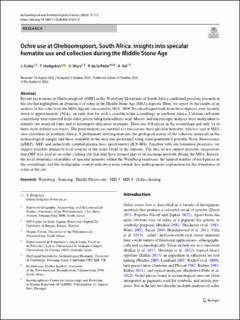| dc.contributor.author | Culey, Jasmin | |
| dc.contributor.author | Hodgskiss, T. | |
| dc.contributor.author | Wurz, Sarah Jacoba Deborah | |
| dc.contributor.author | de la Peña, la | |
| dc.contributor.author | Val, A. | |
| dc.date.accessioned | 2024-03-15T12:19:45Z | |
| dc.date.available | 2024-03-15T12:19:45Z | |
| dc.date.created | 2023-11-24T13:29:53Z | |
| dc.date.issued | 2023 | |
| dc.identifier.issn | 1866-9557 | |
| dc.identifier.uri | https://hdl.handle.net/11250/3122636 | |
| dc.description.abstract | Recent excavations at Olieboomspoort (OBP) in the Waterberg Mountains of South Africa confirmed previous research at the site that highlighted an abundance of ochre in the Middle Stone Age (MSA) deposits. Here, we report on the results of an analysis of the ochre from the MSA deposits excavated in 2018–2019. Fossilised equid teeth from these deposits were recently dated to approximately 150 ka, an early date for such a sizeable ochre assemblage in southern Africa. Calcium carbonate concretions were removed from ochre pieces using hydrochloric acid. Macro- and microscopic analyses were undertaken to identify raw material types and to investigate utilisation strategies. There are 438 pieces in the assemblage and only 14 of them show definite use-traces. The predominant raw material is a micaceous, hard specular hematite, which is rare at MSA sites elsewhere in southern Africa. A preliminary investigation into the geological nature of the ochreous materials in the archaeological sample and those available in the area was performed using semi-quantitative portable X-ray fluorescence (pXRF), XRF, and inductively coupled plasma mass spectrometry (ICP-MS). Together with site formation processes, we suggest possible, primarily local sources of the ochre found in the deposits. The data do not support previous suggestions that OBP was used as an ochre caching site that may have formed part of an exchange network during the MSA. Instead, the local abundance of nodules of specular hematite within the Waterberg sandstone, the limited number of used pieces in the assemblage, and the stratigraphic context indicate a more natural, less anthropogenic explanation for the abundance of ochre at the site. | en_US |
| dc.language.iso | eng | en_US |
| dc.publisher | Springer | en_US |
| dc.rights | Navngivelse 4.0 Internasjonal | * |
| dc.rights.uri | http://creativecommons.org/licenses/by/4.0/deed.no | * |
| dc.title | Ochre use at Olieboomspoort, South Africa: insights into specular hematite use and collection during the Middle Stone Age | en_US |
| dc.type | Journal article | en_US |
| dc.type | Peer reviewed | en_US |
| dc.description.version | publishedVersion | en_US |
| dc.rights.holder | Copyright 2023 The Author(s) | en_US |
| dc.source.articlenumber | 173 | en_US |
| cristin.ispublished | true | |
| cristin.fulltext | original | |
| cristin.qualitycode | 1 | |
| dc.identifier.doi | 10.1007/s12520-023-01871-9 | |
| dc.identifier.cristin | 2201709 | |
| dc.source.journal | Archaeological and Anthropological Sciences | en_US |
| dc.relation.project | Norges forskningsråd: 262618 | en_US |
| dc.identifier.citation | Archaeological and Anthropological Sciences. 2023, 15 (11), 173. | en_US |
| dc.source.volume | 15 | en_US |
| dc.source.issue | 11 | en_US |

